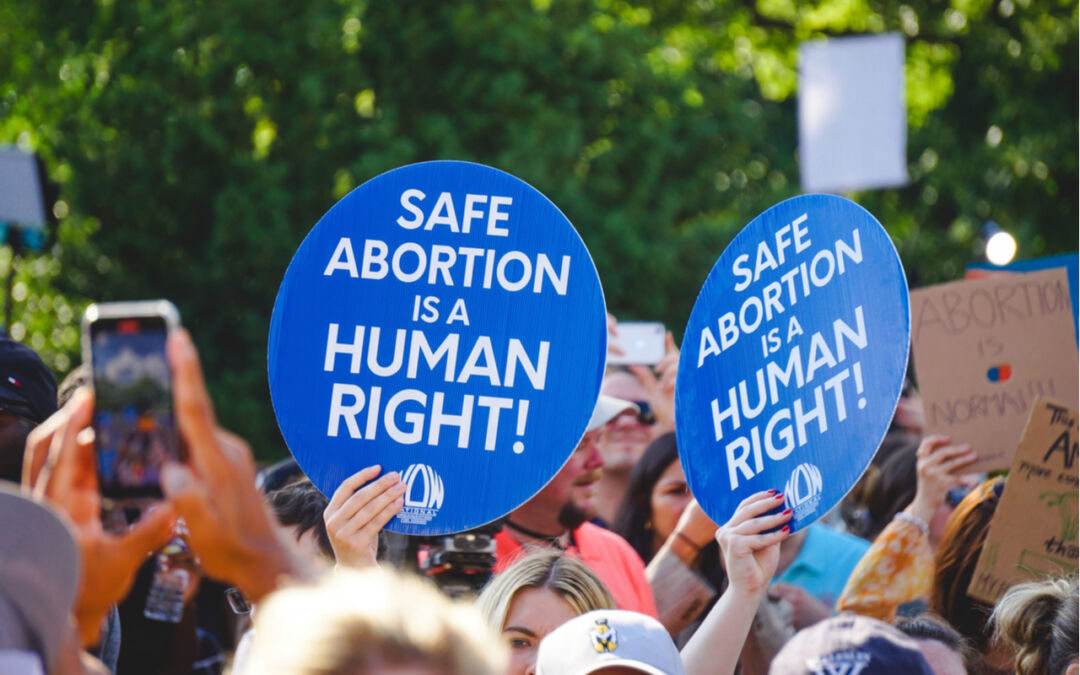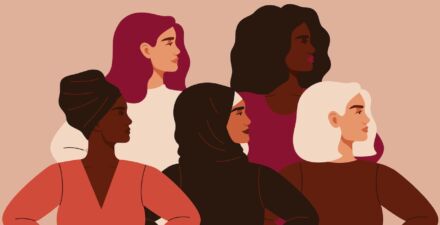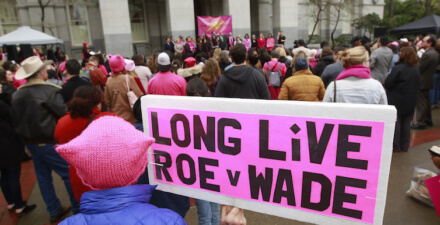Factsheet: What the research says about the economic impacts of reproductive care

Before the U.S. Supreme Court ruling on June 24 in Dobbs v. Jackson Women’s Health Organization, more than five decades of liberating access to contraception and abortion care had demonstrable effects for women’s economic outcomes in the wake of the previously precedent-setting Supreme Court decisions in Griswold v. Connecticut and Roe v. Wade. These economic outcomes are now under threat.
Women today make up almost half of the overall U.S. labor force, compared to just one-third in 1950, and are the backbone of maintaining family incomes. These outcomes were influenced at least in part by the ability of people to have more autonomy over planning if and when to start a family. Access to reproductive care and control over family planning provided rightful bodily autonomy to people to control their lives and decisions, and enabled more women to participate in the labor force and pursue higher education—and thus earn higher wages and match into jobs that are more fulfilling for them.
Even before the Dobbs ruling, the right to access abortion and contraceptives more broadly—legalized in the early 1970s—faced restrictions in various states and picked up following the 2010 midterm elections that ushered conservatives into power in state legislatures across the country. These restrictions were already limiting women’s economic opportunities based on where they live. After the June 24 Dobbs decision, women’s economic opportunities will only worsen in these states and perhaps be further exacerbated by other attacks on rights and freedoms in the future.
A wide body of research demonstrates that access to reproductive care is fundamental in ensuring economic well-being for women and their families. This research also finds that access to reproductive healthcare is particularly critical for women of color, who face additional economic barriers imposed by structural racism, such as longstanding and widespread occupational segregation.
This factsheet details the existing literature on the economic impacts of access to reproductive care and what restrictions to abortion care or contraception will mean for the U.S. economy and labor force. But these economic consequences laid bare by research are only partial, as bodily autonomy and family planning underlie economic security and well-being in myriad ways throughout the life cycle.
The reproductive care policy landscape until Dobbs
The Supreme Court decisions in Griswold and Roe expanded access to contraception and abortion care, respectively, but the U.S. Congress never passed a law protecting these rights. Now that the U.S. Supreme Court has overturned Roe, state legislatures will be able to decide whether and how people who may become pregnant can access this important reproductive care. Here are some of the consequences:
- One in 4 U.S. women—59 percent of whom are already parents and the majority of whom are in their mid- to late 20s—are projected to have an abortion by age 45. That access to abortion is considered a human right by the United Nations’ Office of the High Commissioner on Human Rights. Now, it is not accessible across much of the United States.
- Since the Roe v. Wade decision, states across the country have strategically limited women’s access to abortion care through restrictions on the conditions under which women can receive abortion care, including gestational limits that ban abortion after a specific amount of time after conception, mandatory counseling and waiting periods, requirements for invasive ultrasounds, and targeted restrictions of abortion providers, also known as TRAP laws, that are specifically designed to foster the closure of health clinics that provide abortion care, among other restrictions.
- Research from the Guttmacher Institute—a nonprofit reproductive health organization—suggests that as many as 26 states are certain or likely to ban abortion in the wake of the Supreme Court’s Dobbs decision overturning Roe. Of those 26 states, 13 have trigger laws, or abortion bans that will automatically take effect once Roe no longer stands.
- A recent analysis from Michael Ollove at The Pew Charitable Trusts indicates that several states are also taking aim at access to contraception, such as emergency contraception pills (known as the morning-after pill or Plan B) and intrauterine devices, or IUDs. Many of these state legislatures are also taking steps to limit funding for family planning at reproductive health centers, which could restrict access to contraception, particularly for low-income women, many of whom live in contraception deserts.
Federal legalization of abortion following Roe increased women’s economic opportunities and advancement
Several studies have looked at how the legalization of abortion following the Roe v. Wade decision in 1973 changed economic conditions facing women in the United States. Because abortion was legal in some states and not others prior to Roe, economists have been able to leverage this “natural experiment” of comparing women who had access prior to 1973 and those who did not to understand how expanding bodily autonomy through access to abortion care had subsequent economic impacts on their well-being. Specifically:
- A study by Caitlin Knowles Myers at Middlebury College and the Institute for the Study of Labor details the effects for young women of both abortion and contraception access, both of which were expanded in the early 1970s. She finds that it had a significant impact on the ability of people to control their family planning decisions, which allowed them to have higher career aspirations and goals, as well as plan better for their futures.
- A study by the late economist Marshall H. Medoff of California State University, Long Beach finds that though White women have the greatest absolute levels of abortion across the country, disproportionately more Black and Hispanic women seek abortion services.
Other research examines the disproportionate economic effects that abortion expansion has on women of color. Specifically:
- A study by Ali Abboud at The Ohio State University finds that access to abortion before age 21—prime years for investing in human capital, such as higher education and other skills building—delays the age at which women give birth to their first child by at least 6 months, on average. Abboud examines the effects on labor market participation of that delay, finding that wages significantly increase for women as a result of the ability to control when they start a family—and, in particular, Black women see a 10 percent increase in earnings.
- A study from Joshua Angrist at Hebrew University and William Evans at the University of Maryland, College Park finds that reforms to abortion restrictions that expanded access to care led to increased rates of education and schooling among Black women, as well as fewer teen pregnancies and nonmarital births.
Subsequent restrictions of access to abortion care limited women’s economic well-being and reduced access to opportunities
Several studies document the economic consequences for women of being denied an abortion due to gestational limits by comparing women who are forced to carry a pregnancy to term and otherwise-similar women who are able to access abortion care. Specifically:
- Sarah Miller at the University of Michigan and her co-authors find that women’s economic trajectories are similar prior to becoming pregnant, but those women who are not able to get an abortion experience a large increase in financial distress for several years following the denial. The co-authors also find that being denied an abortion increases the likelihood of negative public records, such as bankruptcy and eviction, by up to 81 percent, compared to women from similar financial backgrounds who are able to get an abortion.
- The Turnaway Study similarly finds that being denied an abortion leads to a higher chance of being in poverty up to 4 years later and a lower likelihood of having positive personal life goals in the coming year.
- A study by Diana Greene Foster at the University of California, San Francisco and others finds that women denied abortion care are less likely to be employed full time 6 months after the denial and more likely to access income support programs.
Policy conditions that make it more difficult to access abortion care also shape women’s economic outcomes in those states, which helps us understand the potential impact of bans on abortion. For instance, various studies looking into the effects of TRAP laws find many negative outcomes for women, particularly women of color. Specifically:
- Research by one of this factsheet’s authors, Kate Bahn, with Adriana Kugler, Melissa Holly Mahoney, and Annie McGrew shows that these regulations actually trap women into bad jobs. We find that women in states with TRAP laws are 7.6 percent less likely to go into higher paid occupations than women in states without TRAP laws, controlling for factors such as education, age, industry, and other factors that economists typically think impact occupational mobility.
- Other research by Kelly Jones of American University and Mayra Pineda-Torres, incoming at the Georgia Institute of Technology, looks at how TRAP laws affect women’s education and future income, finding that young Black women are especially impacted by these abortion restrictions, while White women are relatively unaffected. The co-authors find that Black women who are exposed to TRAP laws between the ages of 15 to 23 have lower college completion rates by between 5 percent and 11 percent and lower future family incomes by between 3 percent and 6 percent, compared to similar women who are not exposed to TRAP laws. This is because reduced access to abortion care increased early births among Black women.
- The passage of the Texas TRAP law, HB2, in 2013, which imposed onerous restrictions on abortion clinics, and the subsequent repeal of components of this law in the U.S. Supreme Court case Whole Woman’s Health v. Hellerstedt in 2016, drastically changed the landscape of health clinics that offer abortion care in Texas. Closure of clinics across the state increased the distance many women had to travel in order to access abortion care. In one study by Jason Lindo at Texas A&M University, Caitlin Knowles Myers at Middlebury College, and Andrea Schlosser and Scott Cunningham at Baylor University found that going from 0 to 50 miles distance to a clinic to 50 to 100 miles to a clinic reduced the abortion rate by 16 percent.
- Overall, the effects of abortion restrictions will be felt most strongly by low- and middle-income women and women of color in particular. As the Economic Policy Institute’s Asha Banerjee writes, “Many of the states with preexisting abortion bans held at bay by Roe are also states that have created an economic policy architecture of low wages, barely functional or funded public services, at-will employment, and no paid leave or parental support.”
But it’s not only abortion restrictions that have huge long-term impacts on women’s engaging in the economy. Being forced to carry an unwanted or unplanned pregnancy to term also imposes direct and immediate financial costs on those who become pregnant and their families. Specifically:
- The Economic Policy Institute’s Banerjee notes that women often face professional penalties, including pay cuts—and even get fired—for becoming pregnant.
- Most U.S. workers do not have access to paid parental leave, meaning many have to rush back to work before fully recovering from giving birth to avoid losing their jobs or falling into debt. And that’s to say nothing of the enormous financial burden of maternity care and raising a child in the United States.
Increased accessibility of abortion care improves women’s outcomes
While many studies look at the effects of restrictions to abortion, there is also a body of research that explores expanded access to abortion care through reducing direct costs to individuals. While federal funds cannot be used to reduce costs and increase access to abortion care, due to the Hyde Amendment passed in 1976, direct costs to patients are variable based on decreasing cost through expansion of services—more supply of providers leads to a reduction in prices—as well as state-level dedicated funding to increase access to abortion care. Specifically:
- A study by Elizabeth Ananat at Duke University and her co-authors looks at the effects of a decrease in the cost of abortion on various outcomes in young adulthood. Looking at changing costs from the 1960s through 1970s, as states legalized abortion and then federally after the Supreme Court legalized abortion in 1973, the co-authors find that lower costs for the procedure increased the likelihood of college completion, reduced the rate of access to social insurance and income support programs, and lowered the odds of being a single parent.
- Bahn’s research with her co-authors finds that Medicaid funding for abortion care, available in 16 states from dedicated state-provided funding sources, improves women’s economic outcomes. Women who live in states with Medicaid funding for abortion are more likely to change occupations year-over-year, which is linked to higher earnings and better job matches, compared to women who live in states that do not have public insurance funding for abortion care.
- Research mentioned above by CSU Long Beach’s Medoff finds that Medicaid funding for abortion was particularly critical to Latinas, whose demand for abortion care is more sensitive to access to insurance coverage for abortion care through Medicaid. These women workers already face significant intersectional wage gaps, further exacerbating economic inequality.
Contraception gives women more security over their economic futures
Contraception is also an important part of family planning and reproductive care, and expanded access to birth control was a huge factor in boosting women’s economic security. Specifically:
- The seminal study in 2002 by Claudia Goldin and Lawrence Katz at Harvard University on the birth control pill finds that it had a direct positive effect on women’s long-term career investments, evident in women’s increasing ability to access graduate and professional degree programs, such as law and medical school. The two authors also find that it had an indirect effect: “all individuals could delay marriage and not pay as large a penalty,” which, the authors explain, leads to better matches for women who pursue their careers.
- Another important study in 2006 by Martha Bailey, then at the University of Michigan and now at the University of California, Los Angeles, examines women’s labor force participation as a result of “contraceptive freedom.” She finds that access to the pill increased the number of women in the paid labor force, as well as the number of hours those women worked, because it reduced the likelihood of first births occurring before women turned 22. Bailey writes that her findings suggest that access to birth control before age 21 accounts for 3 percentage points of the 19 percentage point increase in labor force participation rates, and 370 hours of the 450-hour increase in annual work hours among women from 1970 to 1990.
- Further research from Bailey and her co-authors Brad Hershbein at the University of Michigan and Amalia Miller at the University of Virginia finds that this increase in labor force participation rates gave women the chance to invest in new career paths and reduced the gender wage gap.
Conclusion
Economics research on the initial federal legalization of abortion, subsequent changes to accessibility of abortion care, and the broad dissemination of contraception demonstrates the link between reproductive care and economic opportunity for workers. People who can get pregnant face both direct costs, when services become more expensive to secure and unintended pregnancy leads to financial burdens, as well as indirect costs, when it becomes more difficult and uncertain to invest in one’s education and careers in the future.
These costs intersect with other forms of economic marginalization. Research shows that access to reproductive healthcare is particularly critical to women of color. Bodily autonomy is a fundamental human right and the foundation of any individual being able to fully engage in the economy. The U.S. Supreme Court’s June 24 ruling in Dobbs directly threatens all of these economic gains made by women in the United States over the past five decades.




